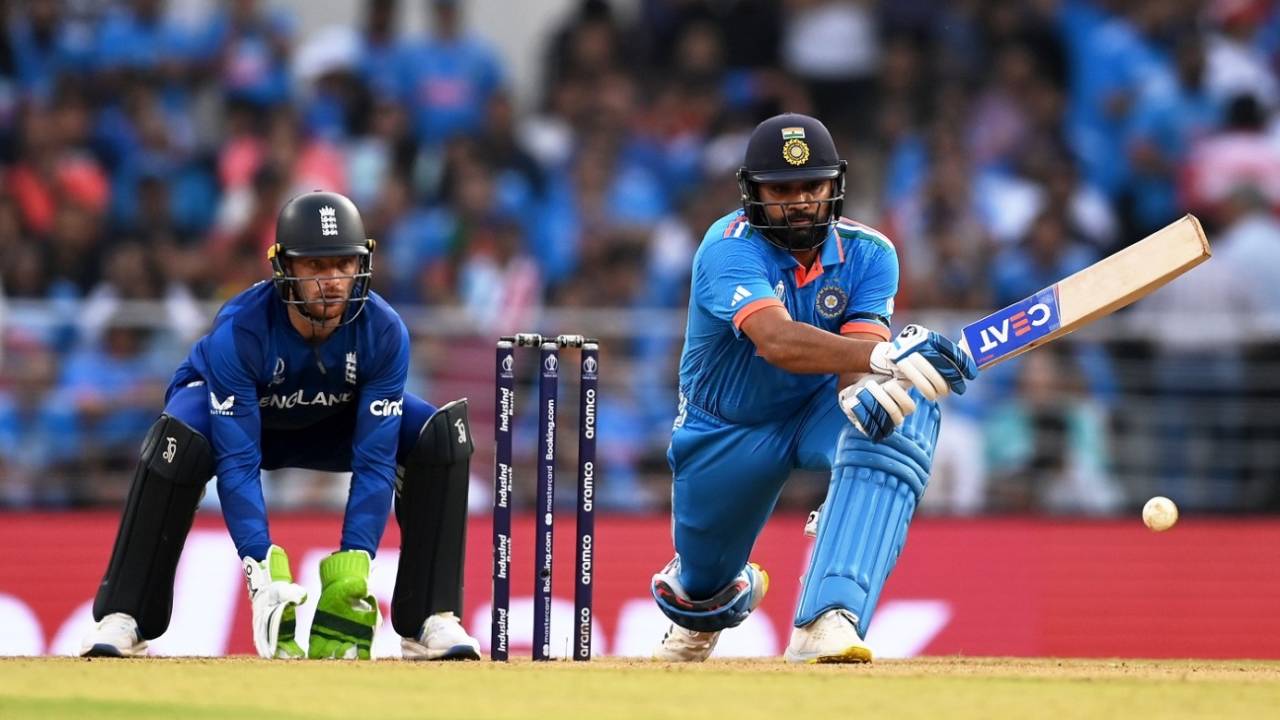"They are a little old-fashioned when opening the innings, aren't they?"
"Too conservative in the middle overs. The world is leaving them behind."
If these lines were said about a strong World Cup contender four years ago, you would immediately think India were being spoken of. During this World Cup, India are not close to looking like that side (they are even stronger contenders, by the way), but there is another strong contender that is playing that sort of cricket: South Africa. In fact, if a team could be an enlarged print of the
Rohit Sharma template that brought him double-hundreds, it is South Africa of the 2023 World Cup.
Rohit himself, though, has burnt down that template of starting slow, getting himself a base, and consistently accelerating through the innings. He is lofting his left-arm nemeses over the infield, he is dancing down to the quickest of bowlers, and he is the quickest batter in the powerplay at the World Cup* bar Travis Head, who has played just one innings, and Jos Buttler who has faced just 12 balls in the first ten overs. Rohit also happens to be the most prolific run-getter during the powerplay.
South Africa are even slower than Pakistan in the powerplay; only Australia are quicker than India. South Africa want that solid base and keep turning the heat on. India want to start red hot, and then just adjust to whatever is required. By the time the death overs come, South Africa become beasts and have been scoring 24 more runs than the next best team in those overs. By the time the death overs come, India have already won the match, so their numbers at the death are not up for any comparison.
India's bowling numbers at the death matter, though, because they have been the best finishing side with the ball: just 5.4 an over and a wicket every 12.72 runs. As a team, India have reversed the ball more than any other side, which makes
Mohammed Shami lethal in the end. They anyway have a bowling god in
Jasprit Bumrah at the end. Their spinners - bowling in the 40-45 band because teams have started to target 35-40 to cash in on the field restrictions - have bowled 13 death overs for 2.88 an over.
In this bizarro world, two of the five quickest batters against spin in this World Cup are South Africans: the fair dinkum spin assassin
Heinrich Klaasen and the vastly improved David Miller. They also have this hitter of hard lengths,
Aiden Markram, in the middle.
Kuldeep Yadav might want to tell them they haven't yet faced a spinner who looks like he has been assembled in a mad scientist's laboratory. He bowls the rarest of skills, left-arm wristspin, but still never leaves the stumps and also bowls at a pace that doesn't let you recover.
Tabraiz Shamsi, whom the South Africa batters face a lot in the nets, will be the first one to tell South Africa batters this is not how left-arm wristspinners are supposed to bowl. They are meant to be error-prone eccentrics who range from awesome to awful. They are not meant to be stock bowlers who keep sprinkling their bit of magic every now and then. Kuldeep averages 16.16 at 4.72 an over in ten matches against South Africa, and that includes only three matches with this streamlined straighter run-up and increased pace.
Then again, despite having steamrolled most big opposition, have India yet faced an attack collectively bowling such pace and with such good form?
Marco Jansen, in this form the closest thing to a lab-assembled pace-bowling counterpart of Kuldeep, has taken a wicket every 16 balls in the powerplay, almost always getting South Africa off to a good start. He is taller than 6'9", swings the new ball, bowls high pace, doesn't fall into the trap of using his height but still gets disconcerting bounce, making his hard length harder than most.
Lungi Ngidi is putting his India and CSK experience to good use, and
Kagiso Rabada's class is shining through in a format longer than just 20 overs. They are averaging a maiden each per game. With
Keshav Maharaj being the banker he has been,
Gerald Coetzee has genuine freedom to be the wild thing.
If India can claim that the real test of South Africa's impersonation of a Rohit innings arrives on Sunday, there is a genuine case to consider this the sternest test for India's batting. This is where perhaps India's batting scores over South Africa's: their overall body of work suggests they are the most versatile batting unit in this World Cup, capable of adjusting their games to the widest array of conditions, whether it be batting first or chasing.
It is fitting that this contest will have a significant say on which team tops the table and thus earns the right to face the fourth-placed team in the semi-final. Tactically the teams won't approach this too differently to the rest of their campaign. The data for match-ups is not even recent enough. Just expect the added element of reverse swing. Expect Mohammed Siraj to come back into the attack before Bumrah as it has happened in matches that India expect reverse in. These teams are Nos. 1 and 3 on the balls-per-six count, but in this strange world, expect Eden Gardens, one of the quick-scoring grounds, to make it more about the bowlers as it has been here so far.
In an ideal world, you would want South Africa to bat first and not be more than two down in 35 overs just to see what really happens when the best death batters face the best death bowlers. And then see how the best chasers react against a hostile bowling unit. In these conditions, though, chances are the bowlers of either side might upset that pattern.
* Stats at the end of the match on November 3.


